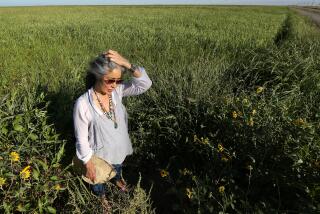Land of Risotto
- Share via
Unlike dishes created from wild, foraged foods, such as mushrooms, fish, game, greens or birds, risotto did not just happen. It is more like fine wine: a coming together of plant and purpose in a particular place.
Rice is not native to Italy. Nor is Italy especially conducive to its cultivation, except in one superb place: the Po Valley. Rice needs massive amounts of water and flat surfaces where the water can pool around the shoots. (Rice fields are flooded to protect tender shoots from freezing.) Only northern Italy’s Po Valley has both. Italy is so mountainous that, apart from the Po Valley, it has no other sizable stretch of flat land except for the Salentine Peninsula, which is the heel of the Italian boot. There, it’s flat, but there’s no water. Only thirst-resistant olive trees and grape vines thrive.
Although appropriate climate is essential (rice likes it warm and humid, which the Po Valley is, swelteringly so, during the summer), the real reason that rice is cultivated in the Po Valley is a geological quirk--along with massive human intervention. The geological quirk is the source of the all-important water.
At first glance, one would think that the Po River itself made rice growing possible. Its water helps, but the Po, surprisingly, is not the main source of supply. Instead, the reason for all the water lies in the soil itself.
North of the Po Valley are the Alps, the snow reservoir for all of continental Europe. As the Alps diminish into foothills, the subsoil changes. It is a brownish, iron-filled subsoil called ferreto with the consistency of cement. Water cannot penetrate it.
What happens is that alpine snowmelt tumbles toward the Po River in seasonally engorged tributaries that stream across the surface of the land. But much of the water percolates into the topsoil. Upon reaching the impermeable stratum of ferreto, it just puddles up underground.
Because the land tilts toward the low point of the Po River, the puddles become underground streams. Eventually, they meet yet another subsoil layer, equally impermeable, of compacted clay. Where the angle of the foothills intersects the flat of the Po Valley plain, this underground water is squeezed up to the surface. The result is hundreds of springs, called fontanili.
On a map, these fontanili follow a traceable line, massed along the northern edge of the Po Valley just where fading foothills meet flat plain. They gush year-round, their waters emerging at a constant temperature and unvarying flow, which make them ideal for irrigation.
More water is diverted from the major tributaries leading to the Po: the Dora Baltea, Sesia and Ticino rivers, along with half a dozen smaller feeder streams. Not to be forgotten are the substantial rains, which fall mostly in the spring and autumn, averaging about 30 inches a year.
With all this water, one would think that the Po Valley must always have been a fertile Eden. Yet the Po Valley was once barren. The brownish topsoil was thin and highly infertile. Close to the rivers, the land was swampy.
The ancient Romans, those masterly engineers, began the transformation of the Po Valley, largely by draining the swampy bogs. But when Rome fell, these efforts ended and eventually the Po Valley reverted to swampy wasteland.
The reshaping of the Po Valley commenced with the arrival and expansion of the Benedictine and Cistercian abbeys between 1000 and the 1400s. Slowly, over centuries, the soil of the Po Valley was invigorated. All the rich topsoil we see today is man-made. Centuries of irrigation and careful, thoughtful, methodical cultivation--adding animal manure, cultivating meadows and, more recently, the application of artificial fertilizers--created an entirely new soil. The Po Valley is as much a cultural landscape as a physical one.
Fashioning canals and diverting water for irrigation were critical too. If the Benedictines and, especially, the Cistercians had not planted their abbeys in the then-barren Po Valley, we would probably not know about risotto today. At the least, the cultivation of rice would have occurred much later.
Today, Italy is Europe’s largest rice producer, growing about 1.25 million tons, slightly more than half of which is grown in Piedmont on 269,000 acres of rice fields. This cultivation is highly concentrated: 96% of the flat plain around the city of Vercelli alone--about 220,000 acres--is under water part of the year. Similar percentages apply to the area around Novarra and dozens of smaller villages of the Po Valley.
It is not a labor-intensive industry. A large rice estate once employed more than 300 laborers; today the staff numbers fewer than 30. The Po Valley has become an agricultural Disneyland, meticulously planned, controlled and lucrative.
But Piedmont is not the sole rice-growing area of the Po Valley. Rice growing extends east into the region of Lombardy and--until recently--into the Veneto region as well.
The inhabitants of all three regions make risotto a way of life at the table, so it’s silly to say that only Piedmont grows the best rice. What is important is to emphasize that risotto can be made only with a few distinctive types of Italian rice. And, not least, by the even more distinctive way risotto is cooked.
More to Read
Eat your way across L.A.
Get our weekly Tasting Notes newsletter for reviews, news and more.
You may occasionally receive promotional content from the Los Angeles Times.









